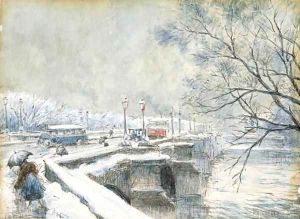Jean Francois Rafaelli Paintings
Jean-François Rafaëlli was a French realist painter, sculptor, and printmaker known for his portrayals of the urban poor, landscapes, and studies of both urban and rural life. Born on April 20, 1850, in Paris, France, Rafaëlli developed an interest in the arts at an early age. His initial focus was on acting, but he eventually turned to painting, studying under the academic artist Jean-Léon Gérôme. Despite this traditional academic training, Rafaëlli was drawn to the avant-garde movements of his time, and his work exhibited a more realist approach.
Rafaëlli's early work reflected the influence of the Impressionists, and he exhibited with them in 1879 and 1880. However, his commitment to the detailed representation of the human figure and the conditions of the lower classes distanced him from the Impressionists, leading him to develop his unique style. His subjects often included the marginalized communities of Paris, such as the ragpickers and the homeless, which he depicted with empathy and a dignified realism.
In addition to his paintings, Rafaëlli gained recognition for his etchings and drypoints, which were remarkable for their technical proficiency and their sensitive rendering of his subjects. He was also an accomplished writer, contributing articles to various journals and writing about the philosophy of art.
Throughout his career, Rafaëlli's work was exhibited widely, including at the Paris Salon, where he received several medals. His commitment to social realism was not only reflected in his artwork but also in his participation in social causes. He was a vocal advocate for the rights of artists and served as the president of the Society of Independent Artists.
Jean-François Rafaëlli died on February 11, 1924, in Paris. His legacy is that of a compassionate observer of the human condition, and his work provides a valuable historical insight into the lives of the urban poor at the turn of the 20th century. Today, his works are held in numerous museum collections, including the Musée d'Orsay in Paris and the Metropolitan Museum of Art in New York.
